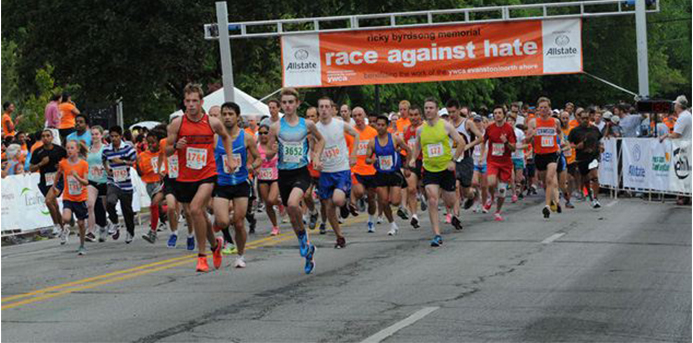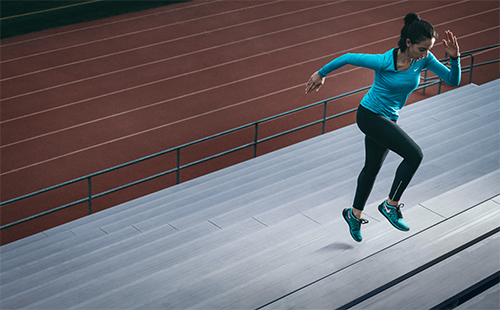You don’t have to run a marathon to be considered a runner. Instead, train for a 5K. In 2015, 7.6 million people — the most of any distance — ran a 5K, according to Running USA.
“I set a goal to run a 5K before I turned 40,” says Gina Ehlman of Wilmette. “I wanted to get out of my comfort zone. Turning 40 seemed like the right time to hold myself accountable every week and try something new. I was never a runner. In fact, when I saw people running, I would think to myself, ‘How is that enjoyable?’ I ran with a group at my same level and increased my stamina each week. I enjoyed the social aspect of the experience and made new friends. Running through the ravines on Sheridan Road, in a light drizzle, pushing myself to run uphill, was exhilarating and frustrating at the same time.”
Here’s how to train for a 5K and get into the best shape of your life.
Why Run
- It is the most efficient path to cardiovascular fitness. Even short bouts of running will improve your heart health and reduce your risk for heart disease.
- Running builds leg and core strength with each stride.
- Running is accessible, flexible and inexpensive. With little equipment required, you can get your workout in anytime and almost anywhere.
- Running, as with other forms of aerobic exercise, elevates your mood, reduces stress, boosts confidence, and has been proven to be an effective treatment for depression.
- Running will help you lose more weight than walking. Few activities burn calories as quickly at running.
- Running strengthens your bones and joints, helping prevent bone loss and arthritis.
- Running can improve your brain power, especially as you age.
- Running is a great social activity allowing you to enjoy uninterrupted quality time with friends and family.
- Running allows you to see more of nature, your neighborhood, and experience all types of weather.
Why Race
Pick a spring 5K to target for your first race. Choose a second one four to six weeks later, and even a third one to pick up your pace a bit. Run the first 5K to try it, the second 5K to know it, and the third to race it to your best time. The excitement of the event, and the satisfaction of completing a race, will leave you wanting more. You will be swept up in the camaraderie of your fellow runners. Signing up for the race means you are committed to yourself and your good health. The upcoming date will keep you on track. You will be more inclined to eat well, sleep seven to eight hours, and limit your alcohol intake while you are in training. You will earn the right to wear the race shirt, and maybe even earn a finishers medal. Did I mention there are usually tasty treats at the finish?
If you are physically fit from walking, spinning, swimming or any other form of exercise, allow four to six weeks to prepare. If you are just beginning an exercise program, check with your doctor to make sure you are ready to begin running. New exercisers should allow eight to 12 weeks before participating in a 5K.
Train Smart
Your body will adapt to running when you introduce it slowly. Many new runners make the mistake of doing too much too soon. Your muscles, joints and bones will strengthen as your running gradually increases, helping to prevent injuries.
- Work with minutes, rather than distance.
- Run outdoors! You will enjoy all types of weather and your runs will fly by.
- Opt for softer surfaces, found on many trails, whenever possible.
- Warm up with 5-10 minutes of walking throughout your training.
- Start by adding 1 minute segments of running, followed by 1 minute of walking.
- Repeat the 1/1 pattern five times, which serves as a great warm up.
- Increase the overall amount of run time, and the time of the run segments. Maintain the pattern of running, then walking, for the same amount of time.
- Shoot for three walk/runs per week.
- Build up to as much as 20 minutes of running, depending on your fitness.
- Cross training will allow you to continue to build cardiovascular strength.
- Rest is where the magic happens, so don’t skip those days.
Here is a sample training plan for a beginner. Make it your own by adjusting it to your fitness level and schedule. Record notes after each workout.
- R/W=Run then walk for the same amount of time, so R/W 2 x 3 is run 3, walk 3, run 3, walk 3
- (W)=The walk time in minutes, which varies from the associated run time
Week One
Monday: R/W, 5 x 1, 1 x 2
Tuesday: Yoga or strength
Wednesday: Cross Train
Thursday: R/W, 5 x 1, 2 x 2
Friday: Rest
Saturday: R/W, 5 x 1, Run 6
Sunday: Rest or easy activity
Week Two
Monday: R/W, 5 x 1, 1 x 3
Tuesday: Yoga or strength
Wednesday: Cross Train
Thursday: R/W, 5 x 1, 2 x 3
Friday: Rest
Saturday: R/W, 5 x 1, Run 8
Sunday: Rest or easy activity
Week Three
Monday: R/W, 5 x 1, 2 x 3
Tuesday: Yoga or strength
Wednesday: Cross Train
Thursday: R/W, 5 x 1, 2 x 4
Friday: Rest
Saturday: R/W, 5 x 2, Run 10
Sunday: Rest or easy activity
Week Four
Monday: R/W, 5 x 1, 4 x 3
Tuesday: Yoga or strength
Wednesday: Cross Train
Thursday: R/W, 5 x 1, 2 x 5
Friday: Rest
Saturday: Run 15
Sunday: Rest or easy activity
Week Five
Monday: R/W, 5 x 1, 3 x 3
Tuesday: Yoga or strength
Wednesday: Cross Train
Thursday: R/W, 5 x 1, 2 x 6
Friday: Rest
Saturday: Run 20
Sunday: Rest or easy activity
Week Six
Monday: R/W, 5 x 1, 3 x 3
Tuesday: Easy yoga
Wednesday: Easy Cross Train
Thursday: R/W, 5 x 1, 2 x 5
Friday: Rest
Saturday: 5K Race
Sunday: Rest or easy activity
Cross train with spinning at Soul Cycle or Spynergy, swim laps at Lifetime or the YMCA, or sweat on the elliptical at LA Fitness or EAC. Cross training will improve your fitness, add variety to your program, and help prevent injuries.
Yoga is a great way to lengthen and strengthen your running muscles. Try a class at YogaView, Bikram Yoga Northshore, or try the online version at Yogaglo.com. Strength training at Redefined Fitness or Body Science is another way to add muscle to your run.
Get Gear
While some run barefoot, that strategy doesn’t work for most runners, especially beginners. The equipment needs are not extensive, but good shoes that work for you are the key to success. “A new runner should pick out shoes with the help of an experienced, professional fitter,” says Nancy Schultz, co-owner of The Runner’s Edge. “The key factor is finding the shoe that is best suited to your personal experience. With our guidance, you will try on a variety of shoes taking into account your biomechanics, goals, routes and distance. The objective is to assist you in finding the shoe that offers the best chance to make your new sport enjoyable, safe, and rewarding.”
Running doesn’t require you wear specific clothing, but buying a few key pieces will make you more comfortable in the heat, cold and rain. Synthetic shirts and pants are breathable, letting your body heat escape and keeping you comfortable. Dress in layers so you can easily shed a layer when you get hot. I suggest doing the walking warm up near your home or car so that you can drop a layer before you run. Fifty degrees is usually a perfect temperature for shorts and a short sleeve shirt. Here is a cool questionnaire from Runner’s World to help you dress for your run.
Sunglasses may also be necessary on a bright day. Look for polarized shades that will not bounce up and down when your run. It’s nice to have a pair you can flip up onto your head when the light changes. Check out the reasonably priced glasses at Suncloud. Plus, many runners enjoy the extra protection from the sun, or rain, that a breathable hat provides. Sunscreen is key for skin protection. Opt for a non-greasy, odorless, water-resistant version like Coppertone Sport.
Running will be so much more enjoyable and relaxing if you leave your mobile device at home. Let this be your time to focus on yourself, free from the distractions of texts, calls and Snaps. A sport watch, like one from Timex, is a great tool to record your minutes. If you want to track a bit more data — the route you covered, pace, and even heart rate — check out the great trackers from Garmin and FitBit.
Ready, Set, Go
With so many great race options, choose one that benefits an important cause, features a scenic course, has a fun theme, or is near your home. Enter the race as soon as possible, before it sells out. Running is booming and 5Ks are popular because they are accessible to all. As race day approaches be ready:
- Review all race information including the location of parking and restrooms.
- Know the race course and consider driving or running it ahead of time.
- Invite a family member or friend to come cheer you on. Arrange to treat them to a healthy meal afterward.
- Plan how you will get to the race. Get there early!
- Choose what you will wear — something that is very comfortable and makes you smile. Lay everything out ahead of time.
- Plan what you will eat the day before and the morning of the race. Avoid anything new.
- Go to the restroom several times before the race start … then go again.
- Line up according to your ability. Let the speedy runners go and take a spot in the middle or toward the back.
- Run your first mile nice and easy. Many go out too fast then fade quickly.
You can find upcoming races in your area here.
“I started with my husband, but told him to run ahead, I needed to do this on my own,” Gina Ehlman says as she describes her first 5K. “Crossing that finish line was an amazing experience! A feeling of accomplishment and pride overcame me as I passed the crowd cheering for me. I had to finish running all the way. No way was I walking. This was my time. That day I became a ‘real runner.’”
Now that you are ready to hit the pavement, here are some running essentials we love.
If you buy something through our links, Make It Better Media Group may earn an affiliate commission.


